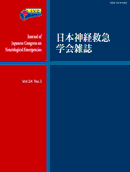Volume 24, Issue 3
Displaying 1-9 of 9 articles from this issue
- |<
- <
- 1
- >
- >|
Review Article
-
2012 Volume 24 Issue 3 Pages 61-70
Published: March 30, 2012
Released on J-STAGE: April 01, 2013
Download PDF (1967K) -
2012 Volume 24 Issue 3 Pages 71-77
Published: March 30, 2012
Released on J-STAGE: April 01, 2013
Download PDF (532K)
Original Article
-
2012 Volume 24 Issue 3 Pages 78-84
Published: March 30, 2012
Released on J-STAGE: April 01, 2013
Download PDF (876K) -
2012 Volume 24 Issue 3 Pages 85-90
Published: March 30, 2012
Released on J-STAGE: April 01, 2013
Download PDF (978K)
Case Report
-
2012 Volume 24 Issue 3 Pages 91-96
Published: March 30, 2012
Released on J-STAGE: April 01, 2013
Download PDF (740K) -
2012 Volume 24 Issue 3 Pages 97-100
Published: March 30, 2012
Released on J-STAGE: April 01, 2013
Download PDF (596K) -
2012 Volume 24 Issue 3 Pages 101-103
Published: March 30, 2012
Released on J-STAGE: April 01, 2013
Download PDF (566K) -
2012 Volume 24 Issue 3 Pages 104-109
Published: March 30, 2012
Released on J-STAGE: April 01, 2013
Download PDF (665K) -
2012 Volume 24 Issue 3 Pages 110-115
Published: March 30, 2012
Released on J-STAGE: April 01, 2013
Download PDF (887K)
- |<
- <
- 1
- >
- >|
